Abstract
STUDY OBJECTIVE: To explore variations in rates for hysterectomy in relation to social class, education, and family income. DESIGN: Retrospective analysis of the 1988 Finnish hospital discharge register linked individually to the 1987 population census. SETTING: Finland. PARTICIPANTS: All women living in Finland aged 35 and over were the denominator population. The numerators were the 8663 women who underwent hysterectomy in 1988. MAIN RESULTS: The overall rate for hysterectomy was 63.5/10,000 women aged 35 and over. There was a marked positive correlation between disposable family income and hysterectomy rates even after age, hospital catchment area, education, and occupational status were adjusted for. However, no linear trend for overall hysterectomy rates was observed in relation to social class or education. Procedures due to myomas, accounting for 48% of all hysterectomies, were more frequent among women of high socioeconomic status according to all socioeconomic indicators. Larger proportions of hysterectomies for myoma were also performed in patients in private hospitals and in pay beds in public hospitals than in women in worse off groups. CONCLUSIONS: Unlike the findings in earlier studies from other countries, there was a positive correlation between income and hysterectomy rates as a result of the high numbers of hysterectomies performed to treat myoma in the well off women. The findings are discussed in terms of socioeconomic differences in the use of private gynaecological services, and factors, such as parity and use of hormonal replacement therapy, that affect the growth of myomas.
Full text
PDF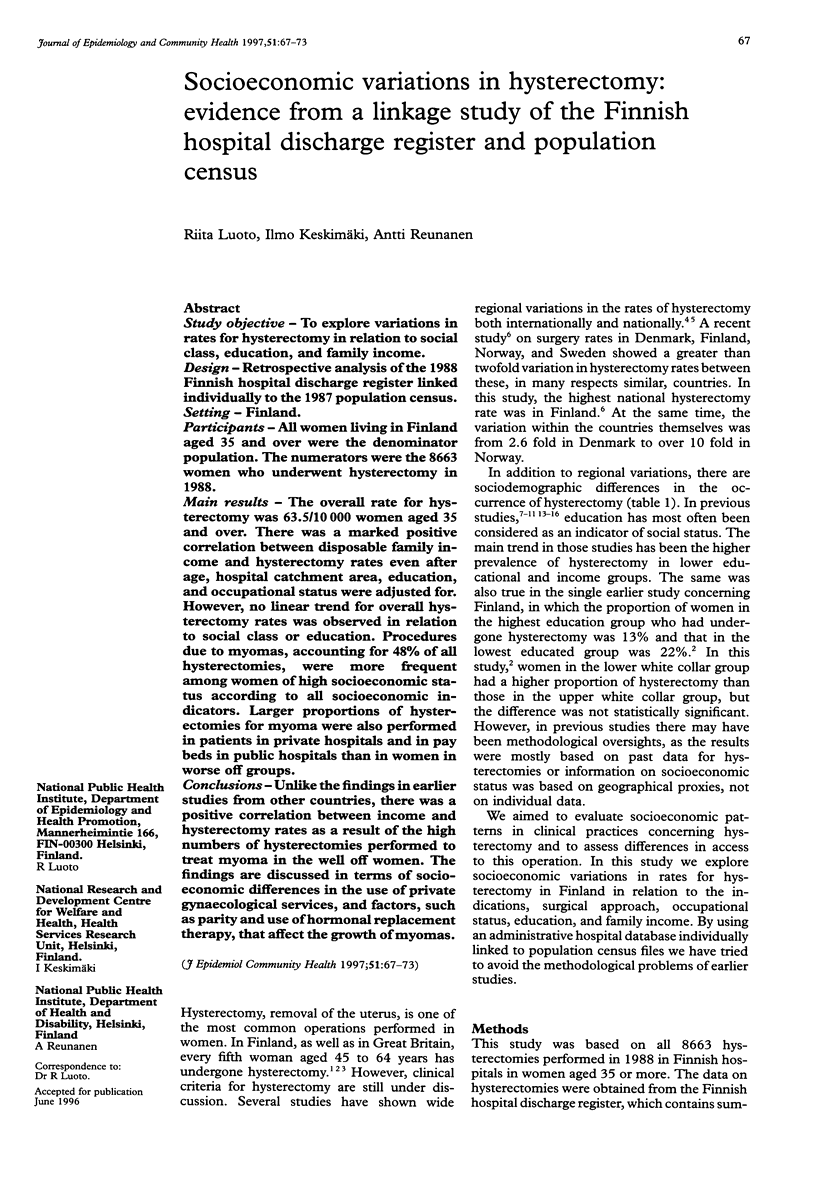
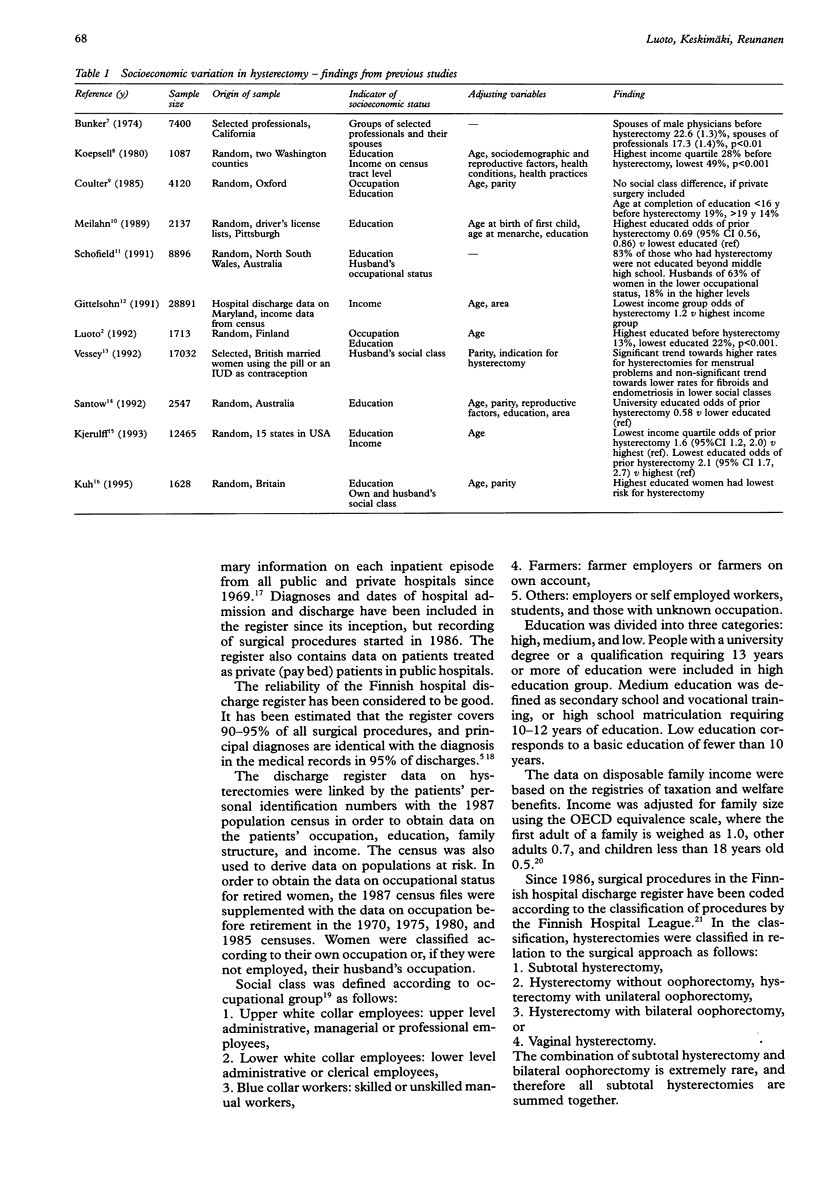
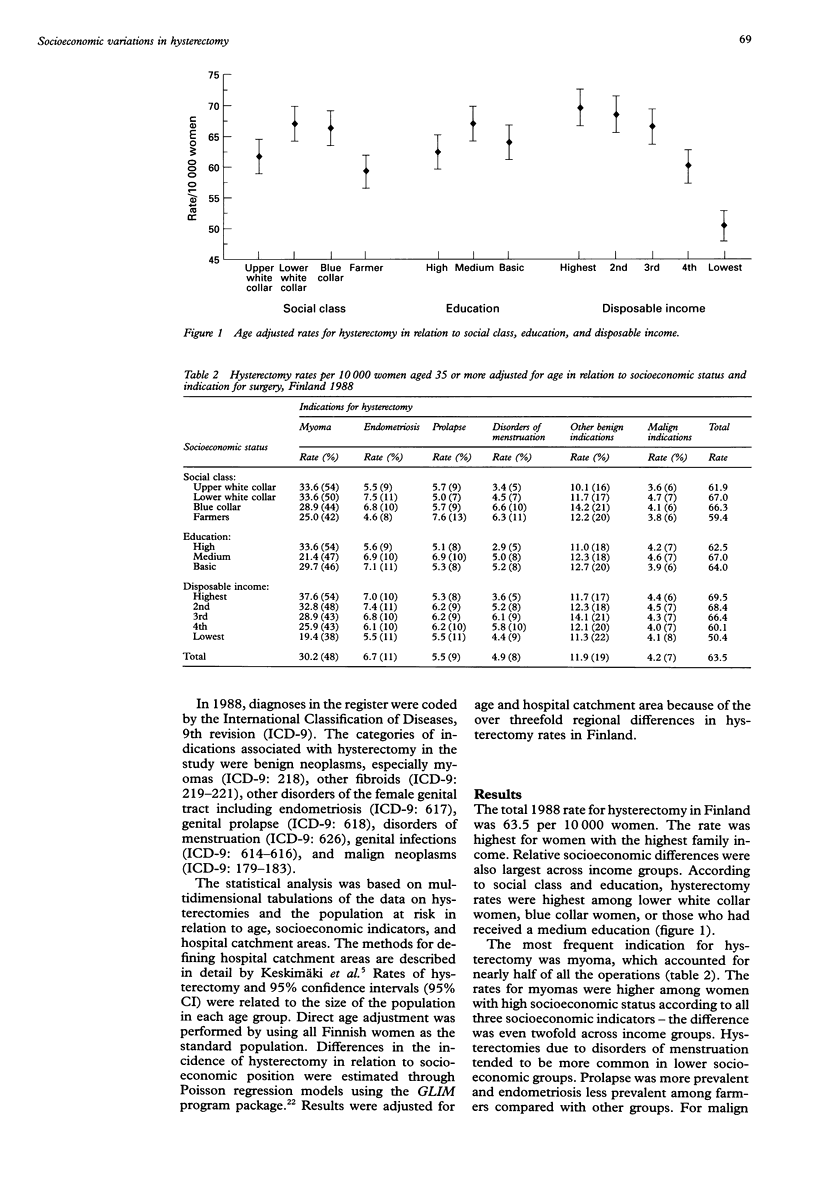
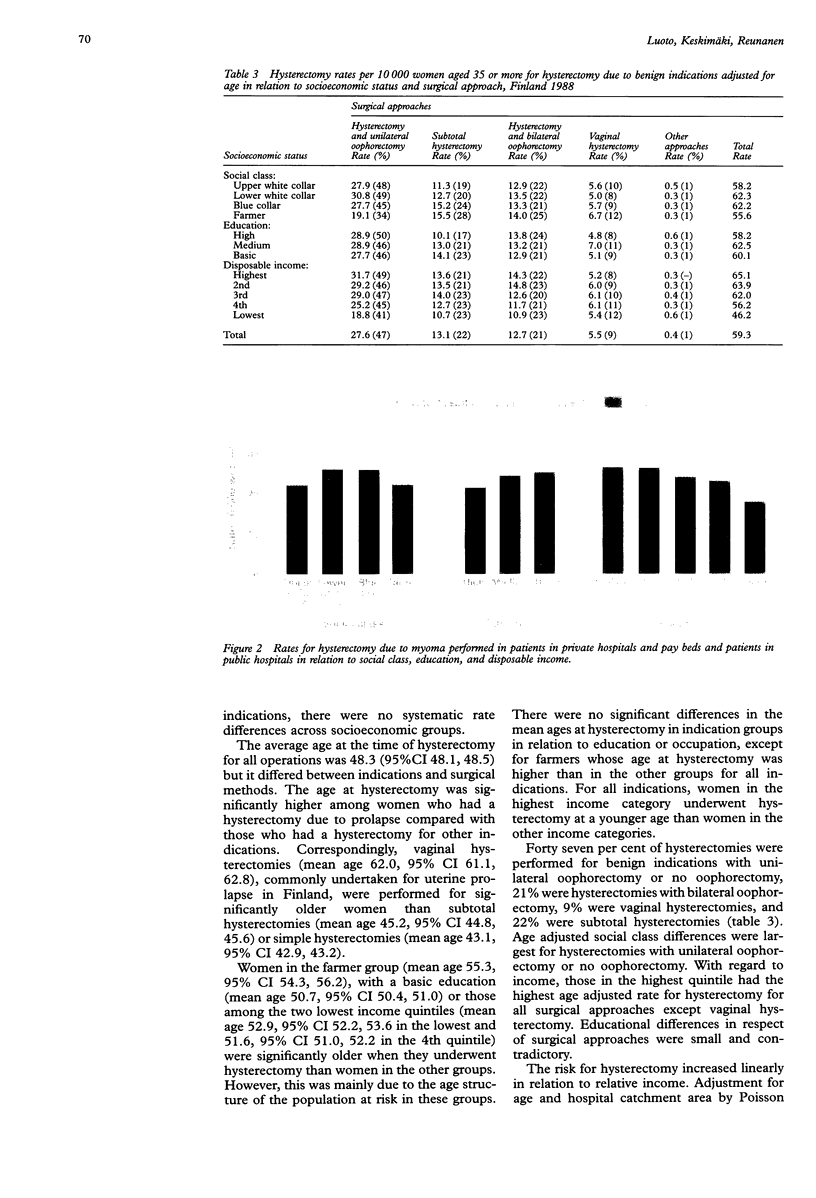
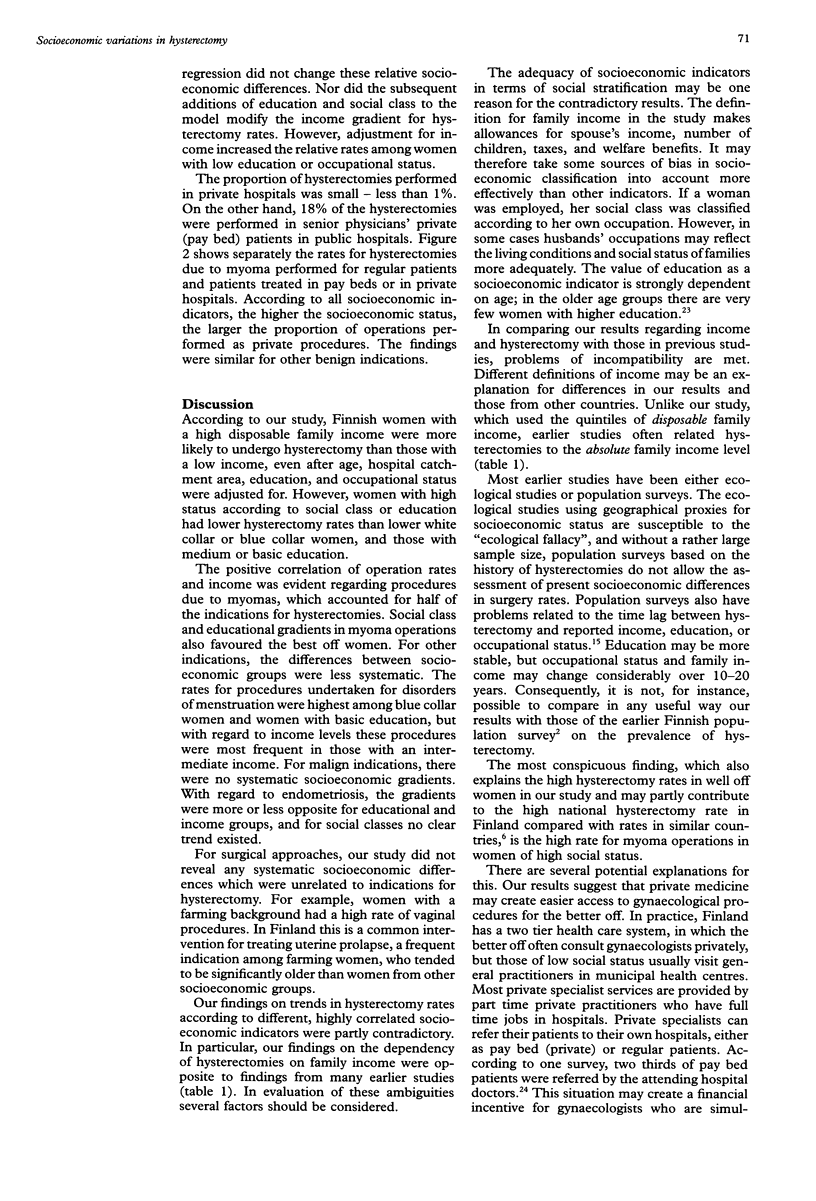
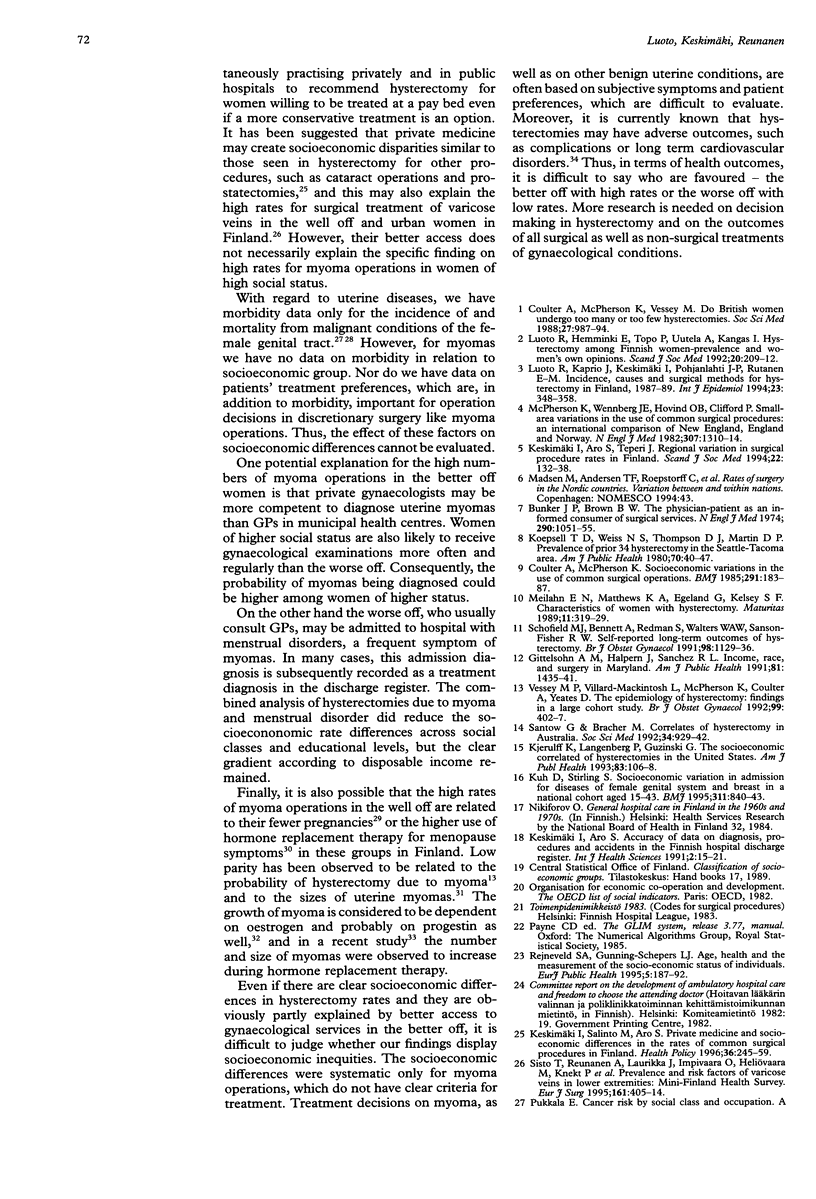

Images in this article
Selected References
These references are in PubMed. This may not be the complete list of references from this article.
- Bunker J. P., Brown B. W., Jr The physician-patient as an informed consumer of surgical services. N Engl J Med. 1974 May 9;290(19):1051–1055. doi: 10.1056/NEJM197405092901905. [DOI] [PubMed] [Google Scholar]
- Coulter A., McPherson K. Socioeconomic variations in the use of common surgical operations. Br Med J (Clin Res Ed) 1985 Jul 20;291(6489):183–187. doi: 10.1136/bmj.291.6489.183. [DOI] [PMC free article] [PubMed] [Google Scholar]
- Coulter A., McPherson K., Vessey M. Do British women undergo too many or too few hysterectomies? Soc Sci Med. 1988;27(9):987–994. doi: 10.1016/0277-9536(88)90289-4. [DOI] [PubMed] [Google Scholar]
- Frigo P., Eppel W., Asseryanis E., Sator M., Golaszewski T., Gruber D., Lang C., Huber J. The effects of hormone substitution in depot form on the uterus in a group of 50 perimenopausal women--a vaginosonographic study. Maturitas. 1995 Apr;21(3):221–225. doi: 10.1016/0378-5122(94)00893-c. [DOI] [PubMed] [Google Scholar]
- Gittelsohn A. M., Halpern J., Sanchez R. L. Income, race, and surgery in Maryland. Am J Public Health. 1991 Nov;81(11):1435–1441. doi: 10.2105/ajph.81.11.1435. [DOI] [PMC free article] [PubMed] [Google Scholar]
- Keskimäki I., Aro S., Teperi J. Regional variation in surgical procedure rates in Finland. Scand J Soc Med. 1994 Jun;22(2):132–138. doi: 10.1177/140349489402200209. [DOI] [PubMed] [Google Scholar]
- Keskimäki I., Salinto M., Aro S. Private medicine and socioeconomic differences in the rates of common surgical procedures in Finland. Health Policy. 1996 Jun;36(3):245–259. doi: 10.1016/0168-8510(96)00816-0. [DOI] [PubMed] [Google Scholar]
- Kjerulff K., Langenberg P., Guzinski G. The socioeconomic correlates of hysterectomies in the United States. Am J Public Health. 1993 Jan;83(1):106–108. doi: 10.2105/ajph.83.1.106. [DOI] [PMC free article] [PubMed] [Google Scholar]
- Koepsell T. D., Weiss N. S., Thompson D. J., Martin D. P. Prevalence of prior hysterectomy in the Seattle-Tacoma area. Am J Public Health. 1980 Jan;70(1):40–47. doi: 10.2105/ajph.70.1.40. [DOI] [PMC free article] [PubMed] [Google Scholar]
- Kuh D., Stirling S. Socioeconomic variation in admission for diseases of female genital system and breast in a national cohort aged 15-43. BMJ. 1995 Sep 30;311(7009):840–843. doi: 10.1136/bmj.311.7009.840. [DOI] [PMC free article] [PubMed] [Google Scholar]
- Luoto R., Hemminki E., Topo P., Uutela A., Kangas I. Hysterectomy among Finnish women: prevalence and women's own opinions. Scand J Soc Med. 1992 Dec;20(4):209–212. doi: 10.1177/140349489202000404. [DOI] [PubMed] [Google Scholar]
- Luoto R., Kaprio J., Keskimäki I., Pohjanlahti J. P., Rutanen E. M. Incidence, causes and surgical methods for hysterectomy in Finland, 1987-1989. Int J Epidemiol. 1994 Apr;23(2):348–358. doi: 10.1093/ije/23.2.348. [DOI] [PubMed] [Google Scholar]
- Luoto R., Kaprio J., Reunanen A., Rutanen E. M. Cardiovascular morbidity in relation to ovarian function after hysterectomy. Obstet Gynecol. 1995 Apr;85(4):515–522. doi: 10.1016/0029-7844(94)00456-N. [DOI] [PubMed] [Google Scholar]
- McPherson K., Wennberg J. E., Hovind O. B., Clifford P. Small-area variations in the use of common surgical procedures: an international comparison of New England, England, and Norway. N Engl J Med. 1982 Nov 18;307(21):1310–1314. doi: 10.1056/NEJM198211183072104. [DOI] [PubMed] [Google Scholar]
- Meilahn E. N., Matthews K. A., Egeland G., Kelsey S. F. Characteristics of women with hysterectomy. Maturitas. 1989 Dec;11(4):319–329. doi: 10.1016/0378-5122(89)90028-5. [DOI] [PubMed] [Google Scholar]
- Rein M. S., Barbieri R. L., Friedman A. J. Progesterone: a critical role in the pathogenesis of uterine myomas. Am J Obstet Gynecol. 1995 Jan;172(1 Pt 1):14–18. doi: 10.1016/0002-9378(95)90077-2. [DOI] [PubMed] [Google Scholar]
- Santow G., Bracher M. Correlates of hysterectomy in Australia. Soc Sci Med. 1992 Apr;34(8):929–942. doi: 10.1016/0277-9536(92)90261-n. [DOI] [PubMed] [Google Scholar]
- Schofield M. J., Bennett A., Redman S., Walters W. A., Sanson-Fisher R. W. Self-reported long-term outcomes of hysterectomy. Br J Obstet Gynaecol. 1991 Nov;98(11):1129–1136. doi: 10.1111/j.1471-0528.1991.tb15365.x. [DOI] [PubMed] [Google Scholar]
- Shikora S. A., Niloff J. M., Bistrian B. R., Forse R. A., Blackburn G. L. Relationship between obesity and uterine leiomyomata. Nutrition. 1991 Jul-Aug;7(4):251–255. [PubMed] [Google Scholar]
- Sisto T., Reunanen A., Laurikka J., Impivaara O., Heliövaara M., Knekt P., Aromaa A. Prevalence and risk factors of varicose veins in lower extremities: mini-Finland health survey. Eur J Surg. 1995 Jun;161(6):405–414. [PubMed] [Google Scholar]
- Topo P., Klaukka T., Hemminki E., Uutela A. Use of hormone replacement therapy in 1976-89 by 45-64 year old Finnish women. J Epidemiol Community Health. 1991 Dec;45(4):277–280. doi: 10.1136/jech.45.4.277. [DOI] [PMC free article] [PubMed] [Google Scholar]
- Vessey M. P., Villard-Mackintosh L., McPherson K., Coulter A., Yeates D. The epidemiology of hysterectomy: findings in a large cohort study. Br J Obstet Gynaecol. 1992 May;99(5):402–407. doi: 10.1111/j.1471-0528.1992.tb13758.x. [DOI] [PubMed] [Google Scholar]



